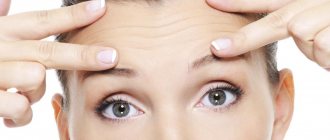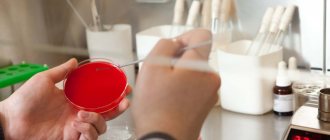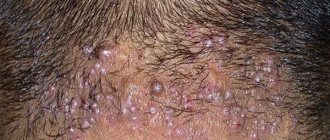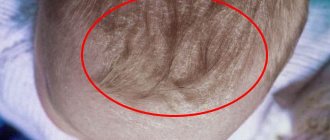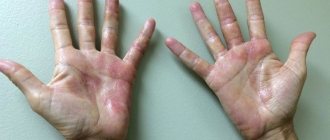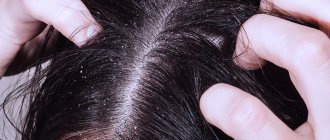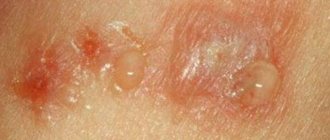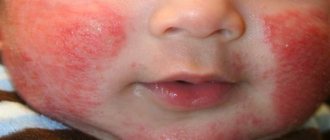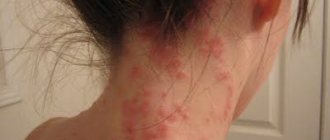Dermatitis on the scalp is a common disease in which the top layer of skin becomes inflamed. This disease affects approximately every twentieth person aged 18-50 years. Two types of dermatitis localized on the head - seborrheic and atopic - have different causes, clinical presentation and, accordingly, require different approaches to treatment.
Analyzing the disease
Symptoms
In order to choose the right treatment, we need to detect the symptoms of dermatitis in time. It should be noted that this disease can manifest itself in a very diverse manner, so here we will present only the most typical picture, and consider specific options separately.
So, what happens with dermatitis?
- One of the first signs of damage to the epidermis under the hair is intense itching. As a rule, unpleasant sensations first appear at the border of hair growth and only then spread.
Photo of seborrheic plaques in a baby
Note! The disease usually develops slowly, so it can take quite a long time from the onset of itching to the discovery of other symptoms.
- Next, a large amount of dandruff appears on the hairy areas. The scales of the exfoliating epidermis thicken and turn from white to honey-yellow.
- Instead of small particles of dandruff, large crusts may form, covering the skin area above several hair follicles.
- Foci of irritation and inflammation form under the crusts: at first the skin simply turns red, and then begins to become wet. If you do not take action, sooner or later seborrheic plaques will appear in these areas, which can bleed and form poorly healing ulcers.
Development of the disease
Types of diseases
As we noted above, a typical picture was described. Diseases in this group are also characterized by other symptoms:
Hair loss due to dermatophytosis
| Disease | Manifestation |
| Atopic dermatitis | The skin becomes dry, and so-called gneiss forms on its surface - scales glued together with the secretion of the sebaceous glands. Characterized by severe itching throughout the scalp. In the vast majority of cases, lesions spread throughout the body. |
| Demodicosis of the scalp symptoms | Irritation is caused by Demodex mites, which damage hair follicles. The disease is accompanied by loss of apparently healthy hair, both over the entire head and in individual areas. The “marker” of demodicosis is actively falling out eyelashes. |
| Dermatophytosis of the scalp | The disease is accompanied by focal baldness and the formation of rounded (in infants - ring) areas of peeling with a diameter of up to 5 cm. Most often found in children. With secondary infection, the scaly areas become inflamed and wet. |
| Streptoderma of the scalp | Phlyctens appear on the surface of the skin - bubbles filled with cloudy liquid. After opening, a long-lasting ulcer remains at the site of the vesicle. It is also possible to develop dry streptoderma - without conflicts, but with the formation of areas of flaky skin. |
| Dermatomycosis of the scalp | Caused by fungi, it is characterized by the appearance of scaly areas with a red rash. There may also be areas of hair loss without a rash. |
| Pyoderma of the scalp | One of the most common dermatoses, especially in children. It is a pustular disease, which is most often aggravated by staphylococcus. Abscesses form under the hair, which, if left untreated, unite into a single infectious focus. |
Mycosis of the scalp
As can be seen from the table, the list of scalp diseases is very extensive. That is why, when determining treatment and prevention strategies, effective diagnosis of pathological conditions comes first.
Probable Causes
In the vast majority of cases, dermatitis is caused by the pathogenic activity of the natural microflora of the scalp. This means that bacteria and fungi that are normally present in our body suddenly begin to exhibit pathogenic properties.
There may be several reasons for this behavior:
- A genetic predisposition that affects the degree of resistance of the immune system to manifestations of infection. It is heredity that quite often determines how intense the manifestations of dermatitis will be.
Typical picture for genetically determined seborrheic dermatitis
- A decrease in the effectiveness of the immune system caused by other diseases, stress, fatigue, lack of vitamins, minerals and nutrients in the diet.
Note! Very often, dermatitis of the scalp is provoked by a sudden transition to a low-calorie diet with low protein content.
- Pathological conditions of the nervous system - Parkinson's and Alzheimer's diseases, paresis, strokes, polyneuropathy, etc.
- Chronic alcoholism.
Alcohol abuse provokes epidermal diseases
- Intoxication (most often with salts of heavy metals).
- Hormonal disorders associated with dysfunction of endocrine organs (adrenal glands, hypothalamus, pituitary gland). These problems may be associated with external influences or be of a tumor nature.
It is precisely this variety of reasons that can provoke a violation of the integrity of the epidermis of the head that leads to the fact that it becomes impossible to make a correct diagnosis, and even more so, to choose an adequate treatment with your own hands. That is why, at the first manifestations of the disease, it is better to consult a professional dermatologist.
Causes
The reasons why dermatitis appears on the face in children are usually classified into:
- biological;
- physical;
- chemical;
- cumulative.
As numerous studies show, only 5% of people living on the planet are susceptible to this disease. Moreover, the manifestation of pathology is most often observed in the first year of a child’s life. Less commonly, dermatitis is diagnosed in children of preschool and school age.
Atopic dermatitis develops more often against the background of the following factors:
- predisposition at the genetic level;
- in persons suffering from bronchial asthma;
- due to an allergic reaction to certain foods, pollen, dust and wool;
- if the child is bottle-fed;
- with uncontrolled use of medications;
- due to frequent infectious and viral diseases;
- for gastrointestinal pathologies;
- developed immunodeficiency;
- when wearing things made from synthetic or semi-synthetic materials.
It is imperative to contact your pediatrician.
In addition, the development of atopic dermatitis can be triggered by unfavorable living conditions, passive smoking and frequent stress.
Therapy
Traditional methods
Instructions for the treatment of dermatitis require at least two aspects:
- First, it is necessary to stop the manifestations of the disease.
- Secondly, it is necessary to identify the cause that caused the pathogenic activity of the microflora and eliminate it.
Microbiological examination of scrapings
Typically, treatment tactics are as follows:
- At the first stage, diagnostics is carried out. To do this, scrapings are taken from damaged areas of the scalp and microbiological examination is performed to identify the parasite.
- A comprehensive blood test is also performed to identify hormonal disorders and metabolic abnormalities.
- After this, medications are prescribed that correct the cause of the disease . These could be medications that stimulate the nervous system, hormonal agents, or antibiotics.
Line of antifungal drugs
- In parallel with general therapy, local treatment is performed. For this, medicated shampoos (Nizoral, Sulsena), as well as creams containing antifungal drugs (Miconazole, Ketoconazole) are used.
- Products containing zinc demonstrate significant effectiveness. They partially dry the skin, normalizing the functioning of the sebaceous glands.
Important! In the presence of advanced seborrhea, seborrheic scales are softened before treatment. For this purpose, special keratolytic shampoos and vegetable oils are used.
UV treatment
- In addition to drug treatment, physiotherapeutic procedures are also used . Dermatitis is relieved using UV irradiation or cryomassage.
Traditional methods
The cost of drug treatment and accompanying procedures can be quite high. For this reason, many people prefer to treat dermatitis on their own, using folk remedies. And although this approach will not eliminate the root of the problem, the recipes of grandparents are quite suitable for relieving the most unpleasant symptoms.
We provide some tips below:
- If the skin itches and peels, you can massage it while rubbing fresh onion or garlic paste.
- For severe seborrhea, it is recommended to use burdock oil compresses. Apply the product to damaged areas of the skin, leave for about half an hour, rinse your hair and thoroughly comb out the softened and exfoliated scales.
Burdock oils with various additives
Advice! To increase the effectiveness of the compress, you can cover it with a plastic cap without holes.
- A decoction of medicinal herbs is a good substitute for water when washing your hair. In this case, thyme, sage, nettle, chamomile, calendula, etc. are used to prepare the product, the beneficial substances from which are extracted by heating in a water bath.
- Finally, one of the most effective remedies is a mixture of oak bark decoction and honey. The resulting mask has good antiseptic properties, therefore it inhibits the development of pathogenic microorganisms for a long time.
Oak bark decoction is a good antiseptic
Prevention
However, it is much easier to prevent the development of dermatitis or at least slow down its transition to the open stage.
To do this, just follow a number of simple recommendations:
- We ensure that the body receives a sufficient amount of nutrients, vitamins and minerals (primarily zinc). To do this, we adjust the diet by introducing fruits, grains, seafood, etc.
Zinc content in different products
- We try to reduce the impact of stress and avoid overwork.
- We reduce the amount of alcohol consumed.
- We monitor the condition of the hair and carry out all hygiene procedures in a timely manner.
- When signs of the disease appear, we consult with specialists to stop problems at an early stage.
Physical activity, fresh air and positive emotions are an essential component of prevention
Treatment
If dermatitis appears on the child’s face, treatment begins immediately. First, you need to establish the root cause that caused the appearance of specific symptoms on the body. After identifying the provocateur of this pathology, treatment is prescribed, during which it is important to follow the following rules:
- complete exclusion of contact with the irritant;
- diet;
- replacing household chemicals with organic ones;
- wearing clothes made from natural fabrics;
- To eliminate the consequences, a cream for dermatitis on the face is prescribed. Locobase Ripea and Protopic are gentle. These drugs moisturize the skin and protect it from drying out;
- in case of complicated course, corticosteroids are included in therapy;
- to remove the irritant, the use of Enterosgel is indicated;
- To relieve an allergic reaction, antihistamines, for example, citrine, are indicated.
Maintaining personal hygiene is one of the measures to prevent dermatitis.
Elimination of the consequences of atopic dermatitis is carried out, in addition to drugs and ointments for dermatitis, also with folk remedies. Bathing in a series and applications with a decoction of bay leaves are useful. Also, when treating the pathology in question, it is recommended to improve the functioning of the intestines by taking bifidobacteria.
It is important to remember that only a doctor can give an exact answer to the question of how to treat the manifestation of dermatitis on the face. You should not self-medicate if a defect occurs.
Tamara (shpilki.net)
VLADIMIR Posted 03/17/2017
Possible causes: hormonal disorders, bacterial infections, decreased immunity, hypothermia and/or acclimatization during sudden changes in weather, taking certain medications, lack of vitamins, unbalanced diet, poor-quality water or improper hair and scalp hygiene (too rare or too frequent washing, incorrectly selected shampoo). If you have metabolic disorders, you should consult a dermatologist to make a diagnosis. If the reasons are external, just follow a few simple recommendations: choose the right shampoo; wash your hair 2-3 times a week; balance your diet: remove fried, sour, spicy, chocolate candies, white yeast bread and baked goods from your diet as much as possible. Additionally, it is recommended to take a course of enterosorbents (Polysorb, Enteresgel, etc.).
Answer
Text \ Photo Ekaterina Posted 10/13/2015
0
share:
To favorites
To print
If you want to thank, add clarification or objection to the author - add a comment!
Currently being discussed:
- Lyubov Burkina
20.08.2018
What hair color should I choose? Please give me some advice. I don't know which one I have...
- I
19.08.2018
I had eyelash extensions for 6 months and took a break. After 3 months I increased it again...
- Vasilisa
18.08.2018
Cool hairstyle
18.08.2018
Hi, can I dye my bleached hair (currently red) bright purple...
16.08.2018
Hello! I am a dark girl with black eyes. I want to dye my hair dark...
15.08.2018
The photo shows young beauties. Can older ladies have their eyebrows done? Age...
Comments »
Atopic dermatitis photo in infants
The main reason for this disease in a baby may be a genetic predisposition.
Important!
Symptoms can be caused not only by diet, but also by poor hygiene or the use of medication by the mother during pregnancy.
The reasons can be completely different , but they almost always cause atopic dermatitis in the baby; a photo of its symptoms in infants was taken to warn parents about the consequences of neglecting basic rules.
Mom's diet for atopic dermatitis in infants
The hypoallergenic diet of the mother of the child is based on the removal of salty, smoked foods, spices and herbs from the diet. The doctor also gives a list of foods to which the baby has had an allergic reaction. This list is always individual, because even a neutral food component can provoke strong negative manifestations in a small organism.
In order for such a list to be as complete as possible, the doctor advises the nursing mother to keep records in which she should note the foods eaten during the day, the time of meal and the reaction of the baby’s skin to them. At the beginning of making such observations, the diet should be as restrained as possible, then the diet should be gradually diversified, alternately and at intervals of several days, adding a variety of foods.
Sample menu for a nursing mother
- Monday. Kefir product, boiled rice, boiled lean pork, pear compote, buckwheat bread, steamed cauliflower
- Tuesday. Kefir product, buckwheat with butter, boiled piece of lean pork, cornbread, sweet tea, boiled potatoes
- Wednesday. You should combine dishes from Monday and Tuesday at your discretion
In the case where the food over the previous three days has not affected the baby’s skin in any way, then from Thursday you can begin to introduce a new product into the diet. It should be eaten in the morning in a minimal amount. In the absence of a negative reaction from the baby, the amount of the new product on Friday, Saturday and Sunday should be increased incrementally to the usual serving size. If there are no manifestations, on Monday morning, the nursing mother can already introduce another new product into her menu.
Diagnostics
Laboratory techniques are important to clarify the diagnosis. General and biochemical blood tests indicate:
- moderate increase in the number of white blood cells (indicates inflammation),
- eosinophilia (indirect evidence of sensitization of the body),
- acceleration of ESR.
Sometimes an increase in transaminases, urea and creatinine is detected (when the functioning of the liver and kidneys is impaired). Stool culture is carried out to identify parasite eggs, since helminthic infestations often act as an etiological factor in children.
- To detect immunoglobulin E in the blood, the test must be taken on an empty stomach.
- The day before, you should exclude animal fats from your diet and stop taking antihistamines and other medications.
- In atopic dermatitis, this immunoglobulin usually increases. Its level is directly proportional to the severity of clinical symptoms.
On the immunogram, the level of interferon in the serum will decrease, the number of T-lymphocytes and immunoglobulins A, M, G will decrease. At the same time, the level of CEC will increase.
